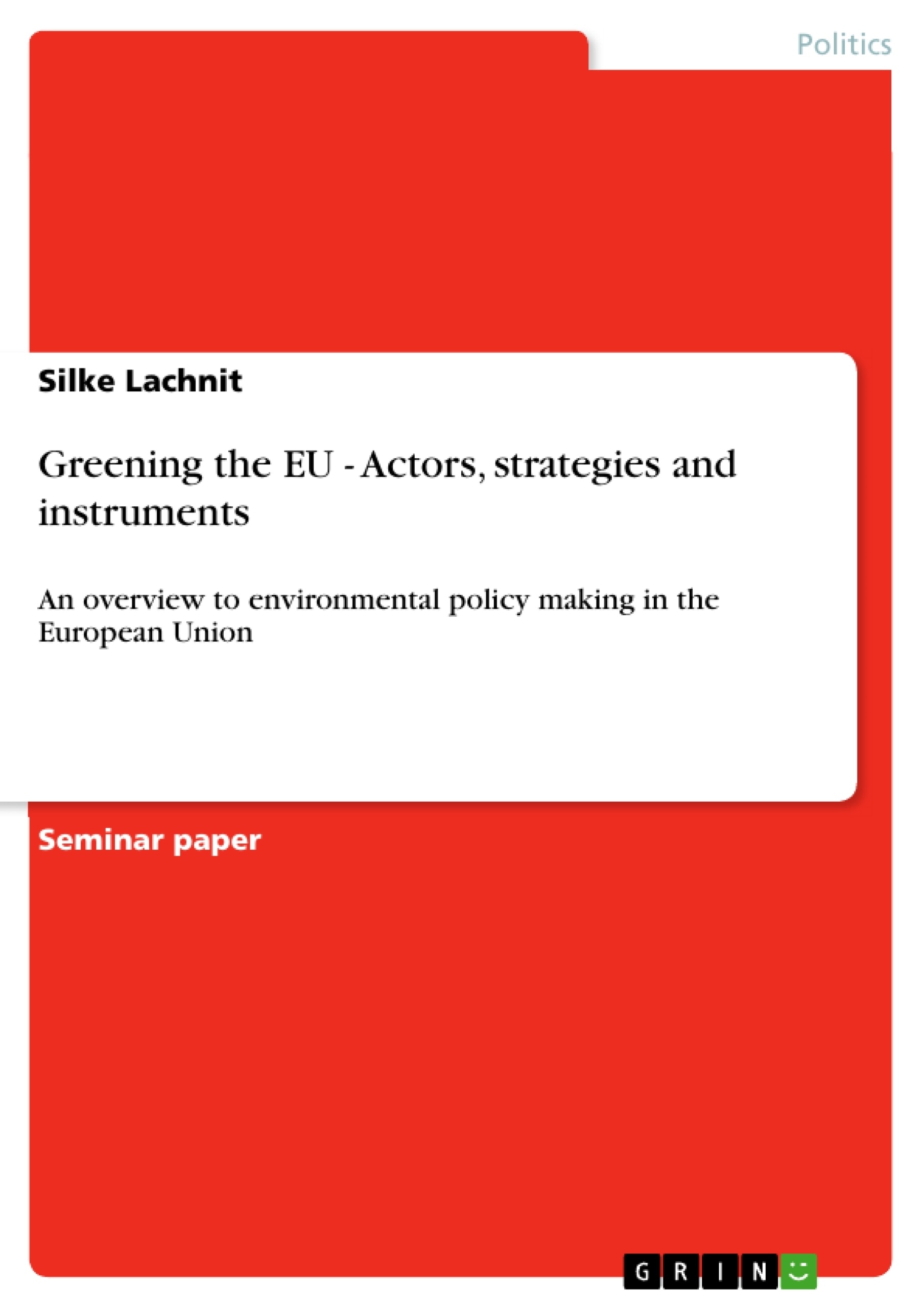This paper is an attempt to give a broad and systematic outline to environmental policy in the
European Union (EU) without discussing explicit or specific problems. Environment is just
one policy field among various others within the EU legislation, and the EU is itself not an
isolated and closed legislative body, but rather to view it as a sophisticated and highly
complex framework at a supranational level into a broader setting of international
organisations and institutions on the one hand and national influences on the other hand. To
catch its formal complexity it is important to look to its origins. The first steps toward EU
integration related to economic issues with the creation of the European Coal and Steel
Community (ECSC), and the Treaties establishing the European Economic Community (EEC)
and finally the European Atomic Energy Community (EURATOM) in 1957. These three
together came to be referred to as the European Community (EC). The creation of the single
European market during the 1970s and the early 1980s symbolises the beginning of the EU
integration process. The term EU was not used before 1992 where it was introduced by the
Maastricht Treaty on the European Union (TEU) which marks a substantial shift from
negative to positive integration of the Member States into the EU framework.1 I will argue
during the analysis that the creation of an economic community as the first step of integration
had strong and significant long-standing effects to the field of environmental policy in the EU.
According to Weale, I will show that “issue linkage and spillover effects have been
characteristic to the development of EU environmental policy” (Weale et al. 2005: 53).
Furthermore, I will point out that this issue dynamic can be explained by the institutional
setting of the EU which provides the ground for multi-level governance which is based on a
high complex system of vertical and horizontal linkages, secondly the issue itself because
environmental issues call for horizontal integration of policy areas and thirdly because of the
interdependence of economic and environmental policy paradigm within the EU to justify
environmental policy making.
[...]
Inhaltsverzeichnis (Table of Contents)
- Introduction
- Actors
- The EU key players
- International influence
- Member States Influence
- Multi-level Governance
- Environmental policy
- Environmental policy and other policy fields
- Environmental policy within the institutional framework
- Horizontal integration
- Environmental policy making
- Policy paradigm
- Instruments
- Implementation
- Conclusion
Zielsetzung und Themenschwerpunkte (Objectives and Key Themes)
This paper aims to provide a systematic and comprehensive overview of environmental policy in the European Union (EU). It examines the EU's environmental policy in the context of a broader framework, considering its interaction with international and national influences. The paper emphasizes the influence of economic integration on environmental policy development.
- The role of actors in EU environmental policy making, including the Commission, Council of the European Union, European Parliament, and non-governmental organizations.
- The interplay of environmental policy with other policy areas, such as trade, agriculture, and competition.
- The institutional framework of the EU and its impact on environmental policy development, particularly its limitations on horizontal integration.
- The evolution of environmental policy paradigms in the EU, from a traditional trade-off between economic growth and environmental protection to the emergence of an ecological modernization approach.
- The challenges of implementing environmental policy in the EU, highlighting the potential for member states to prioritize economic interests over environmental concerns.
Zusammenfassung der Kapitel (Chapter Summaries)
The introduction provides a general overview of the paper's scope and methodology. It emphasizes the importance of understanding the EU's historical development, particularly its economic integration, as a backdrop for environmental policy analysis. The paper argues that environmental policy in the EU is shaped by issue linkage and spillover effects, influenced by both international and national actors.
The first chapter focuses on the actors involved in EU environmental policy. It explores the roles of key EU institutions, including the Commission, Council, Parliament, and Court of Justice, as well as the influence of non-governmental organizations. The chapter also discusses the impact of international and member state influences, highlighting the multi-level governance structure within the EU.
The second chapter examines the nature and scope of environmental policy within the EU. It explores the interdependence of environmental policy with other policy areas, such as trade, market, agriculture, competition, and biotechnology. The chapter analyzes the challenges of horizontal integration and the factors limiting its effectiveness, such as the Commission's sectoral approach to policy making and the Council's focus on national sovereignty.
The third chapter delves into the process of environmental policy making in the EU. It examines the underlying policy paradigms that guide environmental policy development, highlighting the shift from a traditional economic growth-centric approach to an ecological modernization paradigm. The chapter discusses the challenges of implementing environmental policy, especially the potential for member states to prioritize economic interests over environmental goals.
Schlüsselwörter (Keywords)
This paper focuses on key concepts related to EU environmental policy, including multi-level governance, horizontal integration, issue linkage, spillover effects, ecological modernization, policy paradigms, and the interplay of economic and environmental policy.
- Quote paper
- Silke Lachnit (Author), 2008, Greening the EU - Actors, strategies and instruments, Munich, GRIN Verlag, https://www.grin.com/document/116091



